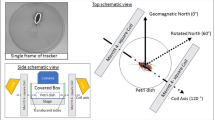Abstract
Homing pigeons and migratory birds are well known examples for animals that use the geomagnetic field for their orientation. Yet, neither the underlying receptor mechanism nor the magnetoreceptor itself is known. Recently, an innervated structure containing clusters of magnetite nanocrystals was identified in the upper beak skin of the homing pigeon. Here we show theoretically that such a cluster has a magnetic-field-dependent shape, even in fields as weak as the Earth's magnetic field; by converting magnetic stimuli into mechanical strain, the clusters can be assumed as primary units of magnetoperception in homing pigeons. Since the orientation of the strain ellipsoid indicates the direction of the external magnetic field, a cluster of magnetite nanocrystals also has the potential to serve as the basis of the so-called inclination compass of migratory birds. It is quantitatively demonstrated that the magnetic-field-induced shape change of a cluster can be amplified as well as counterbalanced by means of osmotic pressure regulation, which offers an elegant possibility to determine the magnetic field strength just by measuring changes in concentration.
Similar content being viewed by others
Author information
Authors and Affiliations
Additional information
Received: 18 May 1998 / Revised version: 11 February 1999 / Accepted: 11 February 1999
Rights and permissions
About this article
Cite this article
Shcherbakov, V., Winklhofer, M. The osmotic magnetometer: a new model for magnetite-based magnetoreceptors in animals. Eur Biophys J 28, 380–392 (1999). https://doi.org/10.1007/s002490050222
Issue Date:
DOI: https://doi.org/10.1007/s002490050222




